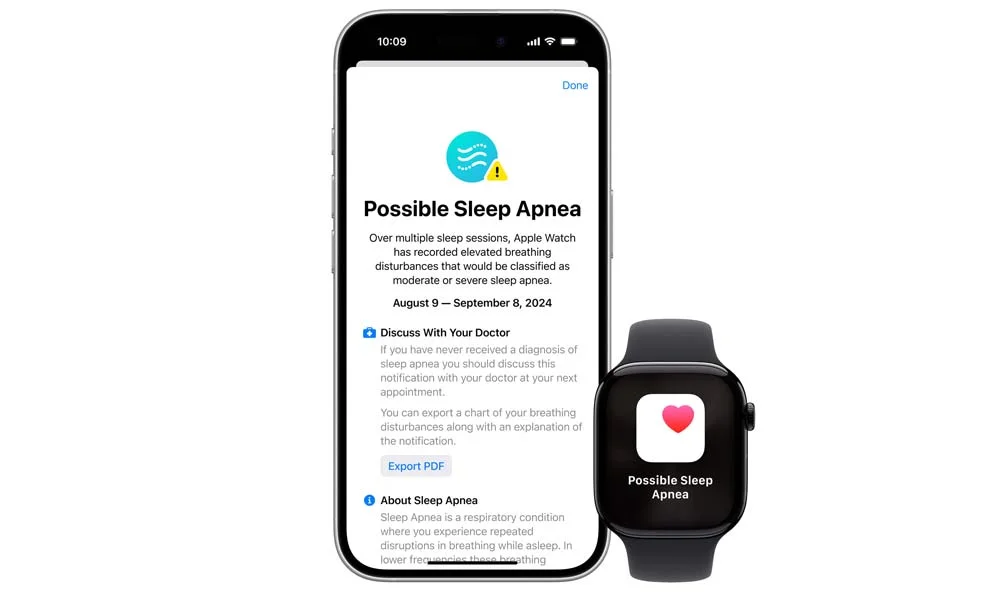
- Apple announced its brand new sleep apnea detection feature on September 9th. (1)
- The feature received FDA approval on September 16th. (2)
- Apple’s sleep apnea detection feature uses machine learning algorithms to analyze the users sleep and alert users if they are experiencing regular disruptions to their sleep (1)
- Users can take the data that their Apple Watch collects and take it to their doctor to discuss a possible sleep apnea diagnosis (1)
On September 9th, Apple announced that their new line-up of Apple Watches would be able to detect symptoms of sleep apnea while the wearer sleeps. The wearer’s Apple Watch will monitor their breathing over 30 days, and then alert the wearer if the watch registers signs of sleep disruptions. (1)
The United States Food and Drug Administration (FDA) published approval for Apple’s sleep apnea detection feature on September 16th. (2) This means that users will be able to take advantage of the feature if they purchase a new Apple Watch or update their compatible watch.
If you’re not familiar, almost every fall, Apple announces their new line-up of smartphones, headphones, and Apple Watches. While nitty gritty software updates and small features can get lost in the shuffle of big announcements of the day, this sleep-focused Apple Watch software upgrade is really standing out.
Apple Watch users have been able to get insights into their sleep for a while, with features that allow you to track your sleep stages, how you set sleep goals, track potential ovulation while you sleep, and more (3,4). Apple’s recent foray into sleep apnea marks the company’s first venture into the detection of sleep apnea.
How Does Apple’s New Sleep Apnea Detection Feature Work?
According to Apple’s press release on the new feature, the sleep apnea detection feature uses a new “Breathing Disturbances” metric to determine whether or not you are experiencing significant disruptions to your sleep because of disruptions in your breathing. Apple says that “Breathing Disturbances can be influenced by alcohol, medications, sleep position, and more. Users can view their nightly Breathing Disturbances in the Health app, where they are classified as elevated or not elevated, and can be viewed over a one-month, six-month, or one-year period.” (1)
Essentially, Apple’s goal is to provide you with data that you could bring to your doctor to determine whether or not you could be experiencing sleep apnea. Your watch will track your “Breathing Disturbances” and then send the data to your iPhone where it analyzes whether or not you’ve potentially been experiencing sleep apnea. Users can even print out a PDF that shows when you could’ve been experiencing sleep apnea symptoms while you were sleeping. (1)
As for the algorithm that determines whether or not you could’ve been experiencing sleep apnea symptoms, Apple says it “was developed using advanced machine learning and an extensive data set of clinical-grade sleep apnea tests.” Additionally, Apple noted that “the feature was then validated in a clinical study — unprecedented in size for sleep apnea technology. In the clinical validation study, every participant identified by the algorithm had at least mild sleep apnea.” (1)
When Will I Be Able to Use Apple’s New Sleep Apnea Detection Feature?
There’s no specific word on when users will be able to access the sleep apnea detection feature on their Apple Watches yet, with the company only saying accessibility beginning “this month.” (1)
Additionally, users in more than 150 countries and territories will be able to use the feature once released, including the United States.
Are There Other Smart Sleep Apnea Detection Features Out There?
The Apple Watch isn’t the only smart-wearable with sleep apnea detection capabilities out there. Samsung’s Sleep Apnea detection feature for the Samsung Health Monitor app was approved by the FDA earlier this year, and according to the company’s press release on the matter “The feature will be available on the Galaxy Watch series in the U.S. via the Samsung Health Monitor app in the third quarter.” (5)
Additionally, the ever-popular Oura ring does have some features that are sleep apnea detection adjacent. While Oura says that the Oura ring “cannot be used to diagnose sleep apnea, it can provide helpful insights on the quality of your sleep,” it can be used to detect reduced deep sleep that can be caused by sleep apnea which “may be reported as excessive awake time in the Oura App.” (6)
Sources
Apple introduces groundbreaking health features to support conditions impacting billions of people. Apple. September 9, 2024. https://www.apple.com/newsroom/2024/09/apple-introduces-groundbreaking-health-features/
- 510(k) Premarket Notification. FDA. September 16, 2024. https://www.accessdata.fda.gov/scripts/cdrh/cfdocs/cfpmn/pmn.cfm?ID=K240929
- Track your sleep with Apple Watch. Apple. https://support.apple.com/guide/watch/track-your-sleep-apd830528336/watchos
- Receive retrospective ovulation estimates (Apple Watch Series 8 and Apple Watch Series 9 only). Apple. https://support.apple.com/en-us/120357
Samsung’s sleep apnea feature on Galaxy Watch first of its kind authorized by US FDA. Samsung. February 10, 2024. https://news.samsung.com/global/samsungs-sleep-apnea-feature-on-galaxy-watch-first-of-its-kind-cleared-by-us-fda
- Oura & medical conditions. Oura. https://support.ouraring.com/hc/en-us/articles/360038214494-Oura-Medical-Conditions#:~:text=While%20the%20Oura%20Ring%20cannot,time%20in%20the%20Oura%20App.




























